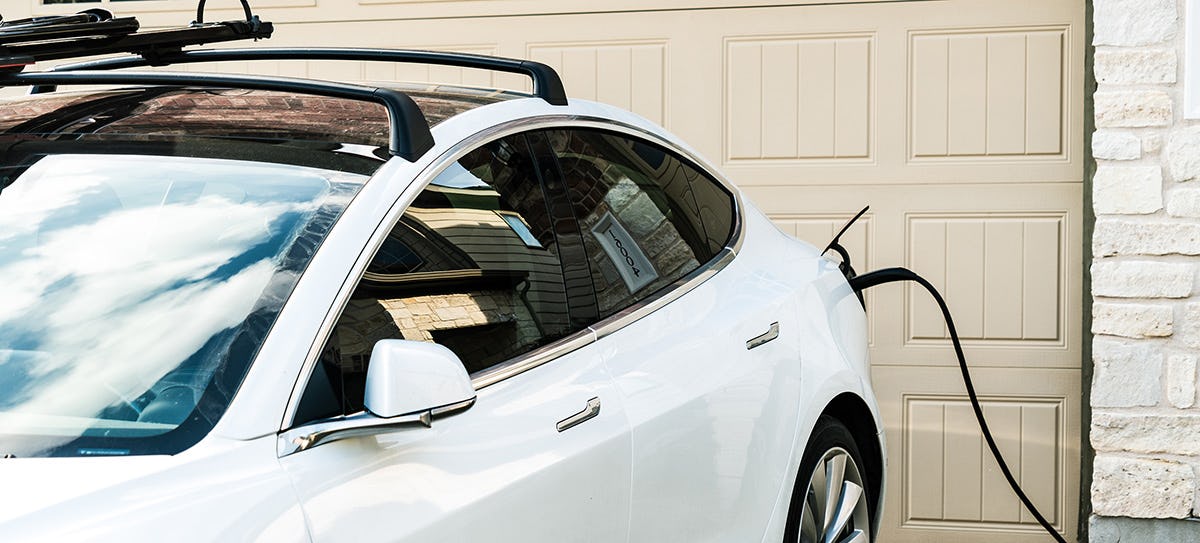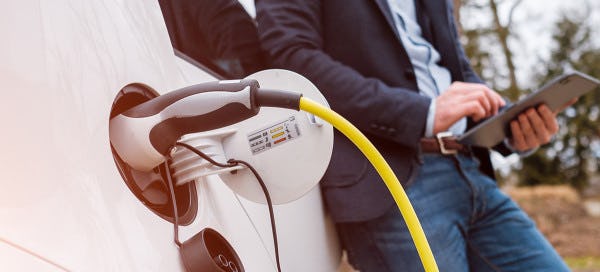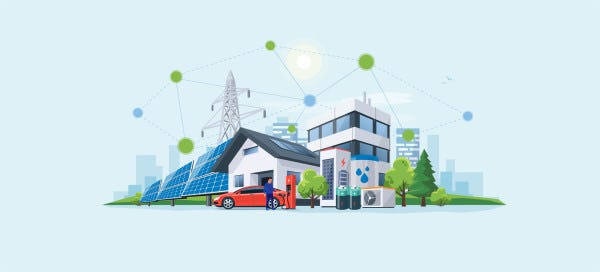Powered by electricity instead of fueled by gasoline, an electric vehicle (EV) is a refreshing departure from traditional transportation. Without needing to fill up, electric car owners are replacing the concept of ‘stopping for gas’ with the implementation of a home EV charging station. But just as with any new technology, there is a need to adjust practices and familiarize yourself. Let’s run through the basics of home EV charging stations to get you ready to electrify your life.
What is an EV Charging Station
Commonly referred to as an EV charging station or an EV charger, the hose and nozzle equipment associated with EV charging doesn’t actually charge the vehicle. The actual charger is embedded within the EV itself. The ‘EV charger’ actually serves to safely funnel electricity from a power source to your electric car battery. So, the technical term for an EV charging station is Electric Vehicle Supply Equipment (EVSE), but we’ll refer to it here as an EV charger or as an EV charging station because that is what it’s more commonly called.
EV Charging Terminology
To better understand EV charging, it’s important to know some of the basic terms:
Kilowatt (kW) — A kilowatt (1,000 watts) is a measurement of power and is equal to the volts (V) multiplied by the amperes (amps) — watts = volts x amps.
Volts (V) — The pressure of the electricity flowing through a circuit. The higher the circuit voltage, the more electrons that are flowing through it.
Amperes (amps) — A measurement of the flow of electrical current through a system. The higher the amps, the more electricity can flow through a system; lower amps have a bottleneck effect which adds resistance to the electrical flow.
As it relates to electric vehicles, there are two significant kW ratings to note:
Motor Power — Here, kW is to electric vehicles what horsepower is to gasoline-fueled cars. As a measurement of power, the kW motor power refers to how much energy could be discharged in a second of maximum output. So, the higher the motor’s kW rating, the more instant power it can release.
Charging Capacity — EVs also have a kW measurement for the amount of electricity that can be taken in when charging the vehicle. Higher kW ratings means that more electricity can be supplied to the car battery at once, thus speeding up the recharging process. Because advancements will undoubtedly be made in EV car batteries, it’s sensible to get an EV charger with a higher kW charging capacity than your current EV can handle so you reduce the need to get a new EV charger when you upgrade your electric vehicle.
Alternating Current (AC) — This is the way homes use electricity. Plugging electronics into the wall will deliver AC electricity to your devices.
Direct Current (DC) — This is the way electric car batteries store electricity. When charging an electric vehicle from an AC outlet, the electric car uses an internal mechanism to convert the electricity from AC to DC.
Important Functions and Features of an EV Charger
While all EV chargers work to safely supply electricity to your electric car, there’s a wide selection of EV chargers to choose from. Despite the variety, all EV manufacturers (except Tesla) have conformed to an industry standard car plug known as the SAE J1772, or the J plug. Even with the uniformity around the J plug, there is still a lot of variety in EV chargers. In order to fit your lifestyle, consider these primary features when looking into which home EV charging station is right for you.
Charging Speed — In North America, there are several different charging levels which dictate how quickly your EV can be charged.
Level 1 Charging allows you to use any 120-volt household outlet to charge your electric vehicle. Portable, 120-volt Level 1 chargers are provided with EVs and require virtually no additional installation to operate. Although Level 1 charging is convenient from an infrastructure perspective, it takes a long time to charge an EV… approximately an hour of charging for 5 miles of driving. This slow charging can help preserve the battery, but it’s not always convenient for people on the go.
Level 2 Charging uses 220-240 volt outlets, like the ones used to power electric stoves or laundry dryers. The higher voltage provided by Level 2 charging results in faster EV charging. It takes roughly 3.5 hours to charge an 80-mile battery. Level 2 charging is the most common type you see at public charging stations. While most EV owners elect to install a Level 2 charging station at home for the convenience of fast charging, there are Level 2 EV charging stations that offer free access to the public (you’ve probably seen them at places like grocery stores, malls and office buildings). Level 2 EV chargers range from 16-amp to 50-amp, with the higher amp chargers allowing for faster charging.
DC Fast Charging converts the electricity from AC to DC before supplying electricity to the vehicle. This is the quickest way to fully charge an EV. A vehicle that can be fully charged with 3.5 hours of Level 2 charging could be fully charged in under an hour with DC fast charging. The complexity and intensity of this charging type leaves it almost exclusively to industrial use, and not all electric vehicles have the capability of connect.
Cable Length — This can be an overlooked feature, but it’s important to keep in mind that your EV will be plugged into a power source, so having a longer cable offers ease and flexibility in reaching the power outlet. Having a 20-foot cable will likely allow ideal reach for most.
Portable or Hardwired — If you live a highly mobile life or divide time between homes, you may want an EV charger that you can take with you. If you’ll charge primarily from one location and want to have a well secured option, then hardwired may be the route for you.
Portable Level 2 EV chargers plug into a 240-volt outlet and can be taken with you as you please. This allows convenient access. In addition, they are easier to repair than hardwired EV chargers. Because it plugs into an outlet, there will be some resistance heat produced at the junction between the outlet and the charger.
Hardwired EV charging stations are connected directly to the electric supply. These EV charging stations are secured and mounted in place, making them more resistant to theft. Any EV charging station delivering over 40-amps must be hardwired.
Weather Resistance — It’s important to consider where your car is parked the majority of the time. If you usually park outside, take into account the natural elements and choose an EV charging station that can withstand them.
Smart EV Charging Station —Some home EV charging stations simply charge your electric vehicle without any bells and whistles. For those who want a more interactive experience, there are smart charging stations that enable users to monitor and review charging behavior. Some smart EV charging stations interconnect with the larger electric grid to assist with demand side response measures, providing EV owners financial incentive for their flexibility during times with increased grid demand for electricity.
Reliable Safety — Going with a charger that is safety certified by an institution such as the Underwriters Laboratory can provide the peace of mind knowing that electricity is safely flowing to your car while you are at home.
How To Install A Home EV Charging Station
Because of the technical nuances of adjusting or adding circuit breakers, it’s recommended to consult an electrician for the preparation and installation of an EV charger.
Things to Ask and Answer Before Buying an EV Charger
Before purchasing and installing a home EV charging station, there are important factors to consider that will significantly impact your decision.
Where will your car go? — It’s important to answer this to determine the cable length and degree of weather resistance needed by your EV charger.
Do you have permission to install an EV charging station? — In some cities and towns you may need to acquire a permit to install an EV charging station at your home. If you live in a Homeowner’s Association (HOA) of if you are a renter, you will likely need additional permission from your association or landlord.
What capacity does your service panel have to deliver electricity to your EV? — A designated amount of amps will be needed to direct power to your EV. Therefore, it’s important to make sure that your home service panel has sufficient capacity to deliver the required amps to your EV charging station.
How are you planning for the future? — Electric vehicles and EV charging equipment is relatively new. So, we’re bound to see considerable advances in the coming years. With that said, it’s wise to get a Level 2 charger (remember that a portable Level 1 charger comes with the EV) that has a higher kW output — and thus delivers more amps — so that it’s well equipped to charge your current electric vehicle and future EVs you may purchase down the road.
Purchasing An EV Charger
Most EV manufacturers will have their recommended EV charger vendors, so having a conversation with your car manufacturer is a good place to start the purchasing process. A variety of top-rated EV chargers are sold online at Amazon and at large retail stores such as Lowes and Home Depot.
The most economical EV chargers are around $200, and top-rated EV chargers range from $400 to $700. In addition to the charger, it’s recommended to hire a certified electrician to install the EV charging station. Depending on the contractor, the extent of work needed, and the area of service, installation cost can range from $200 to $1,200.
In addition to saving money on fuel, there are many incentive programs to drive down the cost of purchasing a home EV charging station.
Installing A Home EV Charging Station
Once you’ve selected and purchased the right EV charger for you, it needs to be installed. Installing a home EV charging station requires the installation of an appropriately sized circuit breaker and a 240-volt line from the breaker box to where the EV charger will be located. This new circuit should be able to deliver enough amps for current and future needs, so it’s recommended that the circuit be able to manage 50 amps.
Once the circuit is established, the EV charger can be hardwired directly into the new circuit or an outlet socket can be installed in order to use a plug-in EV charger. Make sure that the socket and the EV charger plug are compatible.
Electrifying Your Life
In the United States, nearly a third of greenhouse gas emissions comes from the transportation sector. By investing in an electric vehicle and a reliable home EV charging station, you are reducing your carbon footprint and paving the way for a decarbonized transportation sector.
Electrification doesn’t have to stop at your vehicle. You can carry that momentum forward and transition to an electricity plan that is powered by clean, renewable energy sources. In doing so, you’ll be powering that vehicle with clean energy that promotes healthy communities. Interested in learning more about EVs? Visit our EV FAQ page or check out our Electric Vehicle Hub to learn about the average cost of ownership or to compare EV models.
To learn more about powering your home EV charging station (and the rest of your life) with clean, renewable power feel free to reach out to us. At Rhythm, we offer 100% renewable energy plans specifically for EV owners. Check out our EV electricity plans today!



